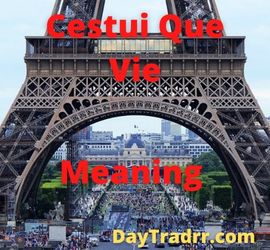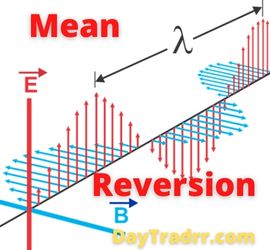What Is Cestui Que Vie?
 Cestui Que Vie is the person for whom a benefit exists and whose life measures the duration of a trust, gift, estate, or insurance contract. The term, Cestui que vie is French for “he who lives“. It is a legal term for a person who is the beneficiary of a trust or an insurance policy. Also, this person has rights to property as well as the income and profits that the property produces. A cestui que trust is a person who is entitled to an equitable share in the estate assets rather than a legal share.
Cestui Que Vie is the person for whom a benefit exists and whose life measures the duration of a trust, gift, estate, or insurance contract. The term, Cestui que vie is French for “he who lives“. It is a legal term for a person who is the beneficiary of a trust or an insurance policy. Also, this person has rights to property as well as the income and profits that the property produces. A cestui que trust is a person who is entitled to an equitable share in the estate assets rather than a legal share.
The same idea is also employed in modern life and health insurance contracts. The cestui que vive is a person whose life spans the period of the insurance contract. Cestui que vie is referred to as the policyholder, insured, or policy owner under these arrangements. As a result, the phrase can apply to the beneficiary of a trust or estate. However, it is more commonly used to refer to the insured rather than the recipient of an insurance policy.
Cestui Que Vie – A Closer Look
Cestui que vive as a legal idea extends back to the Middle Ages, specifically to England. Owners of farms and other property could be gone for lengthy periods of time. Extended travel was required for business, religious, or military purposes. It became critical to guarantee that family members, business partners, and renters could use the land without fear of expropriation by feudal lords. While the individual was gone, the land was cared for by a trustee, who did not have legal ownership of the property.
These trusts were frequently based on the parties’ good faith understanding. In fact, the property was frequently transferred to the Church to avoid paying taxes. The Church was exempt from taxation, yet the successors could continue to live in and enjoy the estates. Under the guidance of Thomas Cromwell and Thomas More, Henry VIII endeavored to invalidate cestui que vive trusts. The process continued during the English Reformation.
Cestui Que Vie Is Now a Part of Modern Law
The Great Plague of 1665 and the Great Fire of 1666 ravaged London. The British government adopted the Cestui Que Vie Act in 1666, reintroducing the legal concept. Hundreds of thousands of British residents died or fled as a result of the twin disasters. As a result, the government placed all private property in trust until the rightful heirs or owners could be identified—the cestui qui vive. Some provisions of the 1666 Act remain in force in the United Kingdom today.
Cestui que vie and its legal applications evolved throughout time. This was in order to combat fraud and ensure that property owners couldn’t move their property into trusts in order to avoid creditors. More recently, regulations prohibiting the holding of property in perpetuity required that persons identified as beneficiaries in a trust must vest and become owners. This means they must have a stake in the trust, rather than passively receiving benefits.
When a trust is established, it is for the benefit of a specific individual named in the trust agreement. The cestui que trust in a trust is the individual who has an equitable stake in the trust. The trustee, on the other hand, receives the trust’s legal title. He who uses (Cestui queue use), is the one to whom the trust is granted. Usage arrangements became so widespread throughout the medieval period that they were frequently presumed to be there even when they had not been assigned.
Cestui Que Vie – Insurance Policies
Cestui que vie is a legal term referring to the person who will be entitled to the proceeds of a life insurance policy following the insured’s death. This phrase is considered archaic. The beneficiary of a life insurance policy is now the common term that replaces a cestui qui vive. Cestui que vive is a subset of the larger idea of cestui que. The phrase cestui que refers to the individual who is entitled to an estate held in trust. Also, this person has an equitable claim to all rents, issues, and profits made from the estate. But, as previously stated, the current legal word beneficiary has supplanted Cestui que. Cestui que vie mostly refers to a cestui que in relation to a person’s life insurance policy. In other terms, the person is named as the beneficiary of a life insurance policy.
Cestui Que Trust
The “cestui que trust” is the individual who is entitled to the equitable estate rather than the legal estate. As a result, the land is granted to Trustee A. in trust for beneficiary B., B. is the cestui que trust. The cestui que usage and trust were based on medieval law. The concepts evolved into a legal means of avoiding feudal payments to an overlord while allowing the land for the use of someone who owed nothing to the lord.
The law of cestui que tends to defer jurisdiction to equity courts rather than common law courts. The cestui que was frequently used by those who had tenancy on the land and owed feudal payments to a lord. However, circumstances might cause them to be abroad from the realm for a lengthy period of time. For example, on a Crusade or a Marco Polo-style commercial adventure. The land might be handed to a third party who was not responsible to the overlord.
Statute of Mortman
This legal position was in some part created in order to avoid the Statute of Mortmain. It was designed to put a stop to the very prevalent practice of leaving real estate to the Church upon the death of the owner. The land never left the “dead hand” since the Church never died. Large tracts of land were bequeathed to the Church prior to the Statute of Mortmain. Subsequently, it was never abandoned. This was in contrast to conventional holdings. These may be passed down through families or revert to a lord or the Crown upon the death of the tenant. For centuries, church land has been a source of strife between the Crown and the Church. Cestui que usage permitted religious orders to use the land while the title was held by a company of attorneys or other groups that had no links to the Church.
Mortmain refers to property held by a ‘dead hand’ and therefore inalienable. Kings and barons objected to persons granting their land to a religious institution and receiving it back again, having shed, in the process, their military and other feudal obligations. The provisions of Westminster (1259) declared against alienation of land without the lord’s permission. Edward I’s statute of 1279 forbade such transfers on pain of forfeiture, to the chagrin of the clergy. (Source: oxfordreference.com)
Up Next: Mean Reverting – What Is Mean Reversion?
 Mean reverting, reverting to the mean, or mean reversion are all phrases used to describe a statistical theory that is employed in finance. It implies that asset price volatility and historical returns will ultimately revert to the dataset’s long-run mean or average level. This mean level can exist and can be applied in a variety of circumstances. For example, economic development, stock volatility, a firm’s price-to-earnings ratio (P/E ratio), and the average return of an industry.
Mean reverting, reverting to the mean, or mean reversion are all phrases used to describe a statistical theory that is employed in finance. It implies that asset price volatility and historical returns will ultimately revert to the dataset’s long-run mean or average level. This mean level can exist and can be applied in a variety of circumstances. For example, economic development, stock volatility, a firm’s price-to-earnings ratio (P/E ratio), and the average return of an industry.
The larger the divergence from the mean, the more likely the next movement of asset values will be in the direction closer to the mean. In other words, an extreme event can increase or decrease a stock’s momentum. However, it is likely to be followed by a less dramatic event that causes significantly less volatility and is in the direction of the stock’s long-term average.




